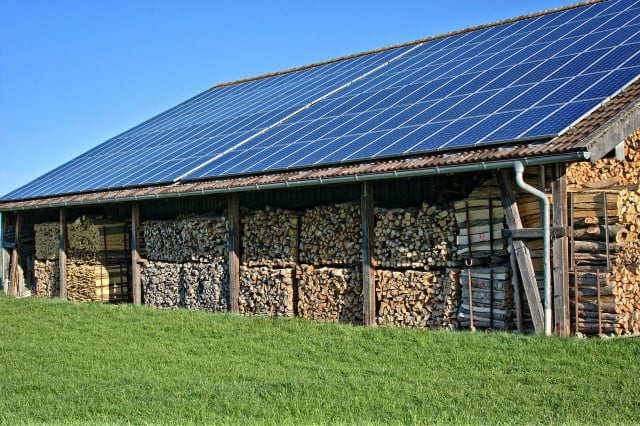Solar energy is a renewable form of energy. We'll discuss the advantages and disadvantages of solar energy and how it is used in the US and worldwide.
Solar energy is energy from the sun that has been converted to thermal or electrical energy. It is clean and renewable and can fulfill numerous purposes, including generating electricity, providing light, and heating water for homes. It can also be employed for commercial and industrial uses.
With solar energy considered so sustainable, it is widely used across the US and continues to grow in popularity. There are three types of solar energy:
- Photovoltaics. Photovoltaic devices generate electricity by an electronic process occurring naturally in semiconductors, the type of material used for solar panels. Electrons in the material, freed by solar energy, travel around the electrical circuit and generate power.
- Solar heating and cooling. These technologies harness the sun’s thermal energy to generate power for hot water, heating, cooling, and pool heating. Solar heating and cooling replaces the need for electricity or natural gas.
- Concentrating solar power. The US has more than 2,500 utility-scale solar photovoltaic (PV) electricity generating facilities. This type of solar power uses mirrors to focus the sun’s energy to power traditional steam turbines and engines that generate electricity.
The Advantages of Solar Energy



(Foto: CC0 / Pixabay / Antranias)
- It is renewable and free. Solar energy is a clean and renewable resource, as electricity is produced by transforming the continuous flow of energy from the sun. The fact that solar energy is powered by the sun means that you don’t have to worry about running out, and a tiny amount of sunlight can provide a huge amount of energy. That makes solar energy more efficient than non-renewable energy sources. Solar panels are even recyclable, making them an even more environmentally friendly way to power your home.
- No fossil fuels are required. No harmful emissions — like greenhouse gasses — are emitted into the air when solar panels produce electricity. Solar energy is low emission and an excellent replacement for non-renewable energy sources like natural gas, which releases carbon dioxide. Natural gas emits methane, a greenhouse gas roughly 90 times more effective at trapping heat in the atmosphere than a single molecule of carbon dioxide.
- It creates green jobs. Solar power for domestic use creates green jobs in a wide range of professional areas, including installation, research and marketing, helping boost local economies.
- Lower electricity bills. Although solar panels come with a high initial cost, using them to power your home will save you money on electricity bills in the long run. Solar panels are also getting cheaper. In its World Energy Outlook 2020 report, the International Energy Agency confirmed that solar panel schemes offer the cheapest electricity in history.
- Power can be stored and used at night. A lot of solar power systems for homes now include solar batteries. These batteries let you store power generated during the day to use at night instead. Storing power means you can choose to live off the grid, as you do not need to rely on buying energy. This makes solar power a more sustainable option for powering your home overall.
The Disadvantages of Solar Energy



(Foto: CC0 / Pixabay / RoyBuri)
- Intermittent energy. Sunlight is required to generate solar electricity, and the process only works when sunlight hits the face of the solar panel. While this can also be considered an advantage, solar panels may not be as effective if you live somewhere that doesn’t get much sunlight.
- High initial costs. Solar panels come with a high initial investment for installation and the cost of a solar panel system itself, which a lot of people may not be able to afford. Although new technologies mean that solar panels are becoming more affordable, they still come with a high price tag. For an average-sized house in the US, the cost of solar panel systems can range from roughly $11,000 to $15,000. Although, as mentioned above, after the initial installation cost, using solar panels to power your home will save you money in the long run.
Solar Energy in the US and Beyond



(Foto: CC0 / Pixabay / 12019)
The US Office of Energy Efficiency and Renewable Energy describes solar energy as “more affordable, accessible, and prevalent in the United States than ever before.” The country’s solar energy generation has increased from 0.34 gigawatts in 2008 to an estimated 97.2 gigawatts today — enough energy to power 18 million American homes.
Solar energy is becoming more accessible to average Americans who want to power their homes in a renewable way. The average cost of installing solar PV panels has dropped by 70 percent. Because of this, solar energy usage in the US is expanding, and it is estimated that it will account for 30 percent of electricity generation by 2030.
Around the world, countries are investing in solar power and this trend is growing as many boost their efforts to reach climate goals. Solar power is also quickly becoming the cheapest option for electricity generation, and countries want to invest.
China has the largest solar capacity globally, alone responsible for 75 percent of the global increase in solar installations in 2020. That year, China’s solar PV capacity additions increased to 48 gigawatts (GW). In comparison, the US increased its solar capacity by 45 percent, reaching 19 GW. Brazil also invests significantly in solar energy, and they have the highest solar investment capacity in Latin America. Meanwhile, in the EU, the markets with the highest growth in 2020 were Germany (+5 GW) and Spain (+3 GW).
So far, solar energy has proven itself a promising form of renewable energy with great potential to replace non-renewable forms of energy going forward.
Read more:
- 8 Best Solar Power Banks for 2022
- How to Clean Solar Panels the Eco-Friendly Way
- Conserving Energy: 10 Ways to Save Electricity
Do you like this post?









